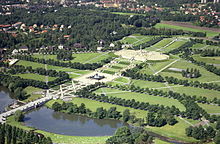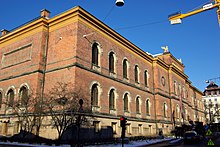![]() Click here to see the map of the area in full screen.
Click here to see the map of the area in full screen.
The Oslo is its capital Of Norway.
At a glance
It is located in the southern part of the country and is its largest city, the city has a total population of 1,403,268 inhabitants. The geographical boundaries of Oslo County and the municipality are common, 22 km². Between 1624 and 1924 it was called Christiania and Kristiania (Christiania).
Ideal period of visit
How to get there
 By air
By air
 By train
By train
 By road
By road
 By boat
By boat
Orient yourself
How to move
What to see







- Vigeland Park (Frognerparken Vigelandsanlegget) (Tram 11-19, buses 22-25-45-46 to Majorstua, tram 12 or bus 20 to Vigelandsparken.). — Free entrance.
- Oslo Opera House (Operahuset), Kirsten Flagstads 1 (Operagata). —
- town hall (Rådhuset) (Metro station National Theater, tram 12 in the direction of Rådhusplassen, buses 70-74 to Vika). - One of the landmarks of the city. It receives 300,000 visitors annually.
- Akershous Castle (Akershus Festning) (Tram 12 or bus 60 in the direction of Bankplassen). —
- Munch Museum (Munchmuseet). - Collection of works bequeathed by Munch in the municipality of Oslo. After the infamous attempt to steal two of Munch's masterpieces that became part of the collection in 2004, it has been transferred to the National Gallery. In addition, a new building near the Opera House is under construction, which is expected to open in 2018. NOK 95 / adult.
- National Gallery (Nationalities), Universitetsgata 13, e-mail: [email protected]. — NOK50. Free admission on Sundays.
- Historical Museum (Historical museum), Frederiks gate 2. —
- Astrup Fearnley Museum (Astrup Fearnley Museet), Strandpromenaden 2. - This is a museum of contemporary art. It is one of Oslo's main attractions because the collections are housed in a state-of-the-art building designed by architect Lorenzo Piano.
- Viking Naval Museum (Vikingskipshuset in Bygdøy), Huk Aveny 35, Bygdøy Peninsula. — NOK60.
- Kon-Tiki Museum (Kon-Tiki Museet), On the Bygdøy Peninsula (Bus No.30> Bygdøynes). — NOK70.
- Fram Museum (Fram museet), On the Bygdøy Peninsula. — NOK80.
See also
- Royal palace (Slottet) (T-Nationaltheateret Metro Station, tram 13-19 to Slottsparken.). —
Museums
- Folklore Museum of Norway (Norsk Folkemuseum), On the Bygdøy Peninsula, ☎ 47 2212 37 00.
Entertainment
Studies
Job opportunities
The Oslo area is its top business center country and has a diversified and dynamic economy with one of the highest regional GDP in Europe. Figures released by the Oslo Regional Development Agency show that per capita GDP in the region was € 44,190 (USD51,950) (excluding oil and gas) in 2000, compared to an average of around € 20,000. (USD23,512) of EU. According to a report prepared by the city's Chief Commissioner and the Ministry of Finance and Development, the services sector is dominated by employment in Oslo. In 2001, public and business services accounted for over 59 percent of jobs. Other important areas of employment are services, commerce, hotels and catering, banking and insurance.

